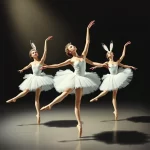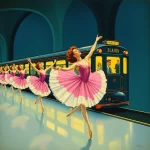Ballet: Les Animaux modèles (Francis Poulenc, 1942)

Introduction
Ballet, an art form that combines music, dance, and storytelling, has produced numerous masterpieces over the centuries. One such gem is “Les Animaux modèles,” a ballet composed by Francis Poulenc in 1942. This ballet, choreographed by Serge Lifar, premiered on August 8, 1942, at the Paris Opéra. “Les Animaux modèles” is a whimsical and satirical work that draws inspiration from Jean de La Fontaine’s fables, bringing to life a series of animal characters in a vibrant and imaginative manner.
Historical Background
Creation and Development
The creation of “Les Animaux modèles” occurred during a tumultuous period in history, marked by World War II. Despite the war’s constraints, the arts continued to flourish in occupied France, serving as a form of resistance and cultural preservation. Francis Poulenc, a prominent French composer, was inspired by the fables of Jean de La Fontaine, a 17th-century poet known for his moralistic and satirical tales featuring anthropomorphized animals.
Poulenc collaborated closely with Serge Lifar, a renowned choreographer and principal dancer of the Paris Opéra Ballet. Lifar’s innovative approach to choreography and Poulenc’s unique musical style combined to create a ballet that was both entertaining and thought-provoking. The collaboration also involved other key figures, including set and costume designers, who contributed to the ballet’s overall aesthetic.
Premiere and Reception
“Les Animaux modèles” premiered on August 8, 1942, at the Paris Opéra. The initial reception was mixed, with some critics praising the ballet’s creativity and humor, while others were less enthusiastic about its unconventional approach. However, the audience generally appreciated the ballet’s charm and wit, and it quickly gained popularity.
Notable early performances included revivals in the post-war years, which helped solidify the ballet’s place in the repertoire of the Paris Opéra Ballet. Over time, “Les Animaux modèles” has been revived and reinterpreted by various companies, each bringing their unique perspective to the work.
Synopsis of the Ballet
Act I Summary
The ballet opens with a lively scene in a forest, where various animals are introduced. The characters include a fox, a crow, a tortoise, a hare, and other creatures, each representing different human traits and behaviors. The animals engage in a series of vignettes that reflect the moral lessons of La Fontaine’s fables.
Act II Summary
In the second act, the animals’ interactions become more complex, with themes of cunning, vanity, and perseverance coming to the forefront. The fox and the crow engage in a clever exchange, while the tortoise and the hare reenact their famous race, highlighting the virtues of patience and determination.
Finale
The ballet concludes with a grand finale, where all the animals come together in a celebratory dance. The resolution emphasizes the moral lessons learned throughout the ballet, leaving the audience with a sense of reflection and amusement.
Musical Composition
Composer’s Role
Francis Poulenc, a member of the French group of composers known as “Les Six,” was known for his eclectic style that blended classical and modern elements. In “Les Animaux modèles,” Poulenc’s music plays a crucial role in bringing the animal characters to life. His score is characterized by its playful melodies, rich harmonies, and rhythmic vitality.
Musical Themes and Motifs
Poulenc’s score features recurring musical themes and motifs that correspond to specific characters and scenes. For example, the fox’s theme is sly and cunning, while the tortoise’s theme is slow and steady. These musical elements enhance the narrative and emotional impact of the ballet, making it a memorable experience for the audience.
Famous Recordings and Performances
Several recordings of “Les Animaux modèles” have been made over the years, showcasing the brilliance of Poulenc’s composition. Notable performances include those by the Paris Opéra Ballet and other prestigious companies, each bringing their unique interpretation to the work.
Choreography and Dance
Choreographer’s Vision
Serge Lifar’s vision for “Les Animaux modèles” was to create a ballet that was both entertaining and thought-provoking. His choreography is characterized by its fluidity, expressiveness, and attention to detail. Lifar’s innovative approach included incorporating elements of mime and character dance, which added depth to the animal characters.
Signature Dance Numbers
Key dance numbers in “Les Animaux modèles” include the fox and crow’s duet, the tortoise and hare’s race, and the grand finale. Each dance is meticulously choreographed to reflect the story and characters, with movements that capture the essence of the animals they portray.
Notable Interpretations
Over the years, various productions of “Les Animaux modèles” have offered different interpretations of Lifar’s choreography. Some have emphasized the ballet’s humor and whimsy, while others have focused on its moral and philosophical themes. These diverse interpretations have kept the ballet fresh and relevant for contemporary audiences.
Characters and Roles
Main Characters
- The Fox: A cunning and clever character who often outwits others.
- The Crow: A vain and gullible character who falls prey to the fox’s tricks.
- The Tortoise: A symbol of patience and perseverance.
- The Hare: A representation of arrogance and overconfidence.
Supporting Characters
- The Lion: The king of the animals, representing authority and power.
- The Ant: A hardworking and industrious character.
- The Grasshopper: A carefree and lazy character.
Famous Dancers
Notable dancers who have portrayed these roles include Serge Lifar himself, who often performed as the fox, and other renowned dancers such as Yvette Chauviré and Michel Renault. Their performances have left a lasting impact on the ballet’s legacy.
Cultural and Artistic Impact
Influence on Ballet and Dance
“Les Animaux modèles” has influenced other works and choreographers by demonstrating how classical ballet can incorporate humor and satire. Its success paved the way for more experimental and narrative-driven ballets, contributing to the evolution of the art form.
Cultural Significance
The ballet’s themes and characters have resonated with audiences beyond the world of dance. “Les Animaux modèles” has been referenced in literature, theater, and other media, highlighting its enduring cultural significance.
Legacy and Revivals
Major revivals of “Les Animaux modèles” have occurred throughout the decades, each bringing new interpretations and innovations. The ballet continues to be performed and celebrated today, ensuring its place in the pantheon of great ballets.
Iconic Productions
Historic Productions
Historic productions of “Les Animaux modèles” include the original 1942 premiere and subsequent revivals by the Paris Opéra Ballet. Key figures involved in these productions include Serge Lifar, Francis Poulenc, and various set and costume designers who contributed to the ballet’s visual appeal.
Contemporary Productions
Recent productions of “Les Animaux modèles” have brought fresh perspectives to the ballet. Contemporary choreographers have experimented with new styles and interpretations, while modern set and costume designs have added a new dimension to the work.
Production Design
The set, costume, and lighting design in various productions of “Les Animaux modèles” have played a crucial role in bringing the ballet to life. From the whimsical forest setting to the detailed animal costumes, these elements enhance the overall experience and immerse the audience in the world of the ballet.
Critical Reception and Reviews
Initial Critical Response
At the time of its premiere, “Les Animaux modèles” received mixed reviews from critics. Some praised its creativity and humor, while others were less enthusiastic about its unconventional approach. However, the ballet quickly gained popularity among audiences.
Modern Reviews
Contemporary critics and audiences continue to appreciate “Les Animaux modèles” for its charm, wit, and innovative choreography. The ballet remains relevant today, with its themes and characters resonating with modern viewers.
Fun Facts and Trivia
Behind-the-Scenes Stories
One interesting anecdote from the production of “Les Animaux modèles” involves Francis Poulenc’s initial hesitation to compose a ballet. It was only after Serge Lifar’s persistent encouragement that Poulenc agreed to take on the project, resulting in one of his most beloved works.
Notable Performers
Famous dancers associated with “Les Animaux modèles” include Serge Lifar, Yvette Chauviré, and Michel Renault. Their performances have left a lasting impact on the ballet’s legacy.
Trivia
- The ballet’s title, “Les Animaux modèles,” translates to “The Model Animals,” reflecting its satirical take on human behavior.
- Francis Poulenc was a member of “Les Six,” a group of six French composers known for their innovative and eclectic styles.
- The ballet’s inspiration, Jean de La Fontaine’s fables, are still widely read and appreciated today for their moral lessons and wit.
Conclusion
Summary of the Ballet’s Importance
“Les Animaux modèles” is a significant work in the world of ballet, combining humor, satire, and moral lessons with innovative choreography and music. Its enduring popularity and influence on other works highlight its importance in the history of dance.
Final Thoughts
Reflecting on “Les Animaux modèles,” it is clear that the ballet’s charm and wit continue to captivate audiences. Whether you are a seasoned ballet enthusiast or a newcomer to the art form, this delightful work offers something for everyone. We encourage readers to watch a performance or listen to the score to fully appreciate its brilliance.
FAQ
What is the central theme of this ballet?
The central theme of “Les Animaux modèles” is a satirical exploration of human behavior through the lens of anthropomorphized animals, inspired by Jean de La Fontaine’s fables.
Who are the main characters in this ballet?
The main characters include the fox, the crow, the tortoise, and the hare, each representing different human traits and behaviors.
What is the most famous dance number in this ballet?
One of the most famous dance numbers is the duet between the fox and the crow, which showcases their clever and vain personalities.
How long does a typical performance of this ballet last?
A typical performance of “Les Animaux modèles” lasts approximately 45 minutes to an hour, depending on the production.
Are there any modern adaptations of this ballet?
Yes, there have been several modern adaptations and revivals of “Les Animaux modèles,” each bringing new interpretations and innovations to the work.
Why is this ballet considered important in the history of dance?
“Les Animaux modèles” is considered important for its innovative choreography, engaging music, and its ability to blend humor and moral lessons. It has influenced other works and continues to be celebrated in the world of ballet.





